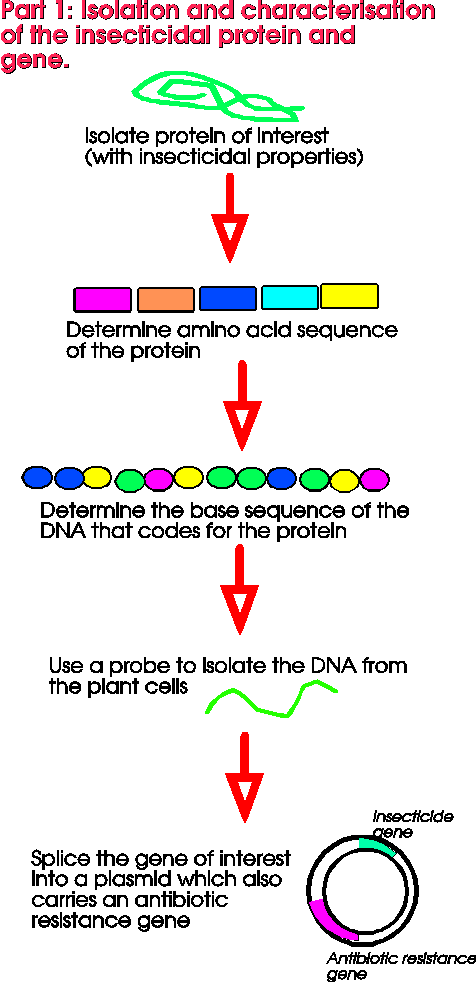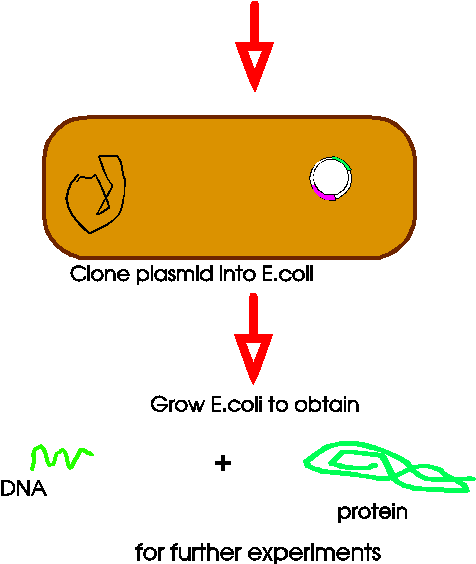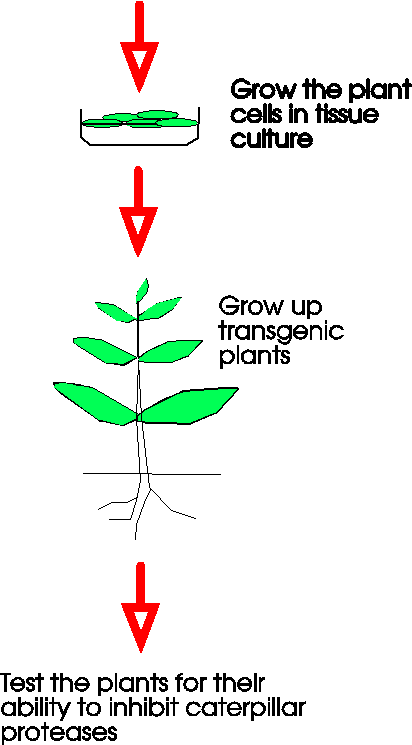

In her final year at school (Year 12), Marilyn studied English, Pure Mathematics, Applied Mathematics, Chemistry, Physics and German.
At University, Marilyn gained a B.Sc (Hons) from Melbourne University, and a PhD in Biochemistry from LaTrobe University.
Since finishing her PhD, Marilyn has worked in the following places:
Dr Anderson is married, with two children (one at uni., one at school). She plays tennis, and is Secretary of one of Melbourne's groups of the Society for Growing Australian Plants.
Interviewer: Can you describe briefly how you are doing whatever you do?
Dr Anderson: First, we clone the genes and identify the proteins they encode. Then we look at the effect of these proteins on insect growth, behaviour and reproduction. When we find proteins with useful properties we put the genes for these proteins in the plants. Then we need to see how the inserted genes interact with other genes and gene products in the transgenic plants.
Interviewer: Who or what (animal or plant) will benefit from your research/techniques?
Dr Anderson: Humans will benefit as the transgenic plants should produce better yields. This would have the effect of providing more sugar or more cotton for human use. But more than that, the techniques we are using may be useful to other scientists in ways we have not even though of.
Interviewer: What are the economic implications of your applied genetics? (How expensive is it to do? What will be/are the cost benefits of the outcome?)
Dr Anderson: Insecticides and their application are a major cost to farmers. If we can develop transgenic plants with reduced need, or better still no need, for insecticide spraying, the cost of production of crops should fall considerably.
Farmers are also trying to reduce pesticide use because the pesticides damage the environment and they have harmful effects on farm workers who are exposed to them.
Interviewer: Historically, what is the scientific background to the research you are now doing?
Dr Anderson: This work has grown out of research into the sexual reproduction, or pollination, of flowering plants. We discovered that the female reproductive organs of flowering plants are rarely damaged by microorganisms or insects. This is presumably because insects and flowering plants evolved together and the plants developed mechanisms to help them attract the insects needed for pollination, but also to defend themselves from consumption so they survived to reproduce. From this observation the natural question to ask is "how do the plants do this?" With the techniques of biotechnology available today, we are able to investigate this question.
Once we know the answer to the "how", we can use biotechnology again to put the genes for the defensive proteins into other cells in the plant and protect the whole plant from insects.
Interviewer: For a Year 12 Biology student to understand what you are doing, some background knowledge of biological concepts will be needed. Can you tell me what biology is relevant to what you are doing, and why?
Dr Anderson: A great many concepts in biology link together in work such as this.
Because we are working with genes it is necessary to understand all about DNA structure and the way, through transcription and translation the gene encodes the protein we are interested in. Sometimes we isolate a likely protein first and use its amino acid sequence to identify the corresponding gene. Sometimes we start with the gene and find its protein. Either way we need to know about the relationship between the DNA triplet code and the sequence of amino acids in the protein.
Mutations and mutagens are important too. We induce mutations in the plants' genes in an effort to alter the genes so that we get improved proteins.
We have found that inclusion of the insect resistance gene's introns in the transgenic plants sometimes leads to better expression of that gene, so we need to understand about both introns and exons in our genes. Regulation of a gene's expression is also important, so we need to make sure that the genes we work with have the correct promotor and terminator sequences too. We also need to know about plant cell structure. We need to put the genes into the cells which are attacked by insects and we need to be able to use particular staining techniques and microscopy to locate the proteins in the cells.
The role of mRNA is important, since we need to get good 'tissue specific' transcription of the gene. It is also important to have a stable transcript (mRNA molecule) in the right tissues at the right time. It is important that the protein ends up in the right cell compartment , or we will not see the change of phenotype we want, even though we have changed the plant's genotype.
My students and I have had to learn about entomology since we started this work. We now raise our own insects here at La Trobe so that we can see if the proteins we are working with affect them in any way.
Our major target pests are Helicoverpa punctigera and Helicoverpa armigera which are major pests on several Australian crops. In cotton farming alone, over $100 million is spent each year to protect the plants from these pests.
The gene we are working with codes for proteins which are proteinase inhibitors. As students would know, proteinases are enzymes involved in the digestion of proteins. The inhibitors we are working with bind to and inactivate the major digestive enzymes (trypsin and chymotrypsin) of several insect species. The result of this is that the caterpillars grow much more slowly and are less able to compete in the crop environment.
Interviewer: I now need to know something of the techniques used in your research. Can you tell me what techniques are important, and why they are important?
Dr Anderson: Many techniques are used in my lab. From keeping the caterpillars alive, to working with DNA, we do it all!
Let's assume that the first thing we do is find an interesting protein. Naturally, purification of the protein is the first step. We then test the pure protein to see how it affects our insects. Here is a flow chart for the first part of what we do:


Next, we can isolate the gene from the plant cells. Knowing the amino acid sequence of the protein and the DNA triplet code we can predict the sequence of bases that code for that segment of protein. We can make a synthetic oligonucleotide with the same sequence of bases as a probe for the gene of interest from the mixture of DNA in the plant's cell.
Once we've got the gene, or actually the DNA we routinely use restriction enzymes to digest the DNA and electrophoresis to separate the DNA fragments.
The pieces of DNA can now be sub-cloned into plasmids that can be transferred into bacteria that are easy to grow, usually Escherischia coli (E.coli). This helpful bacterium will produce lots more DNA which can be used for DNA sequencing or mutagenesis. Or, we can get the E.coli to make the protein product from the gene. The 3-dimensional protein structure can then be determined and it can be tested for biological activity on the insects.
Once we have isolated, and thoroughly tested a gene with good insect resistance, we insert it into a different bacterium, Agrobacterium tumefaciens. This bacterium is chosen for its ability to transfer specific regions of DNA (called T-DNA) into the plant cells. In this way we produce transgenic plants. Hopefully, these plants, when grown up and tested, will display the desired phenotype, insect resistance, because of their altered genotype. Here's another flow chart of the steps we take to get to the plants we are developing.


The last step in the process is field trials of the transgenic plants, and selective breeding from the plants with the 'best' resistance. But by that stage, the work has left our lab and is in the hands of the plant breeders.
Interviewer: What do you see as the major biological implications of the work you are doing? For example; are genotypes or phenotypes being altered? Is a species survival potential increased? Will someone or something have a better quality of life?
Dr Anderson: By definition, the transgenic plants produced in this way have an altered genotype, and we would only want to select plants in which this leads to an altered phenotype. So yes, there are alterations to the plants' genotype and phenotype. The plant strains with the phenotypes we choose will certainly survive, as they will be grown, probably in monoculture, for as long as they remain useful.
Humans, as a species will benefit too if there are better food crops for feeding the expanding world human population.
In modern agriculture, gene transfer is only into 'elite' varieties of plants. Monoculture of these specially selected varieties goes on anyway, and has done so for most of this century.
Gene transfer is just an extension of the sort of breeding programmes that already happen. Varieties are selected which best suit the environment in which they grow. We will work together with plant breeders to ensure that our original transgenic plants are crossed with the best Australian cultivars.
Interviewer: There is often discussion or debate about issues associated with biotechnology. What is one such issue relating to your work? Can you outline the arguments of the opposing sides of the debate please?
Dr Anderson: The whole subject of development of new varieties of plants raises issues of ownership of the new varieties. Genes and transgenic organisms are able to be patented in Australia and transgenic plants are protected by plant variety rights.
Large Companies, many based in the USA, spend millions of dollars in the research and development of transgenic plants. They, quite reasonably, need to protect their investment, and to make money from their 'inventions' for the shareholders and for the continuing research of the Company.
Unfortunately, Australia does not own much of the information in this area. This is worrying, as the thought of monopolies holding the rights to much of this information is a concern.
Sometimes people are worried that production of transgenic plants for food will make them unsafe to eat. This is really not a problem for two reasons:
Firstly, the products of the genes, as you well know, are proteins. And as you also know,proteins which are eaten are digested in humans. So it is very unlikely that the protein products of transgenic organisms could do any harm if eaten.
Secondly, we are not likely to put any 'extra' genes unwittingly into the transgenic plant because the inserted DNA is entirely sequenced before we use it. We also test the gene for its protein product in E.coli as I explained earlier. I cannot see how any 'extra' gene could possibly arrive in the plant.
This also raises the issue of labelling of products made from ingredients obtained from genetically engineered plants. At present the Australian and New Zealand Food Authority is deciding what to do about this. There have been interesting discussions in other countries about this too, and I'm certain that you will find debate about this on the Internet.
Interviewer: Can you suggest some reading material relevant to anything we have discussed about your work, its implications and issues associated with it?
Dr Anderson:
The new Internet site at the Australian Academy of Science (AAS) has some general information on gene technology in plants. Also at the NOVA biology page, part of the same AAS site, there is information about other current biology research. Much of the research reported here is in the area of applied genetic technology.
The Gene Technology Information Unit is also a place where students may find useful information. An Internet search, using Alta Vista, for "Bt cotton" or "Bt toxin" should find many articles. Students need to be aware that the protein we are investigating is not a Bt protein, but many aspects of the techniques used in the development of the Bt cotton are similar to ours.
Interviewer: Thank you for your time.
For ideas on where you might find additional resource material, look again at the section Resources on another page at this site. And don't forget the power of the Internet to provide you with information. A well thought out search, using a search engine such as Alta Vista, should provide more information than you can possibly use!
Please do not phone Dr Anderson for further information for your CAT. She, like the rest of the staff in Biochemistry, is a busy person. However, if you think we can help you some more, use either the comment form or the email address for this site and we will do what we can.
If you would like to read another interview with a La Trobe Biochemistry scientist, you can click here to go back to the Interview Index.
If you would like to 'netsurf' for some more resources, you might find the author's favourite Biology Bookmarks helpful.